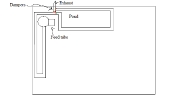I get the desperation. For most of us this is a considerable investment in time and money, and for some of us who are older and disabled, mistakes are not just process but painful. So as somebody in the middle of a similar project, though by far not as expert as many here, I thought that I would share some thoughts. I too am in a northern climate, though a bit more extreme of one. Our RMHs are for a specific goal.
So let's look at the goal for a minute. From the temperature goal you have, I am guessing that you want to do talapia? Blue talapia can go down to 65 F. My plan is to maintain a breed stock in my basement and raise them in the greenhouse in the summer half of the year where we have extremely hot temperatures, I will try something like walleyes that can handle lower temperatures. We also have more sun than you year around. To maintain that water temperature you will have to heat year around if you stick with talapia. The survival range for trout is published at 35 to 75 °F (2 to 23 °C).
Another thought is your layout. Your pond has considerable thermal mass, but you are trying to maintain a temperature, where your cob can get nice and toasty. Ideally you would want to be able to close off one or the other exhausts. Definitely plan a clean out there.
Are you planning to insulate the tank, likely not on the bottom, but the top and sides? Maybe a different top in the summer for me at least.
The thing to think about is that it is a system. Think about how your water will transfer heat in the tank and as the water cycles through your grow beds.
I guess what I am saying is be realistic with your goals in terms of water temperature, and do a dual exhaust with controls so you can decide which thermal mass that you are heating first. Since the mechanism is metal and it is hot coming out of the barrel, this may need regular replacement. Also remember curves need clean outs, so not under the tank.
My hope is that this forum will be a place to bounce ideas, trouble shoot and share experience, so I hope to follow your project and share.



